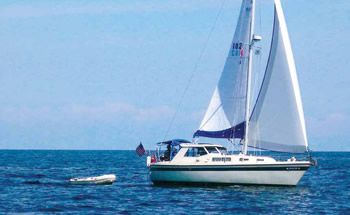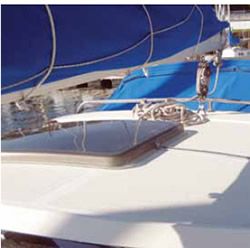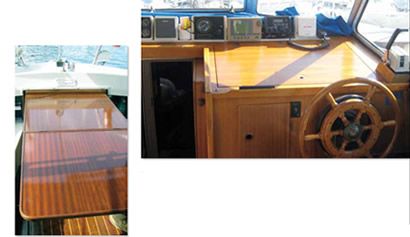Photos by Ron Dwelle

Danish company LM (Lunderskov Mbelfabrik) began as a wood-furniture maker in 1940. In the 1950s, the company started incorporating the newfangled fiberglass into its furniture and changed its name to LM Glasfiber.
In 1972, the company built its first fiberglass sailboat, the LM27, and over the next 20 years, it built 3,000 boats in five models, ranging from 24 to 32 feet. In 1995, LM stopped building boats and concentrated on fabricating giant wind-turbine blades. The manufacturer is now known as the LM Wind Power Group and claims to be the worlds largest maker of the blades. Unfortunately, the company no longer has anything to do with LM sailboats.
Most LM boats were sold in Europe, but for several years in the 1980s, about a fourth of their hulls were sold in the U.S., particularly in the Great Lakes and East Coast areas. A drastic change in the currency exchange rate raised their price significantly, ending imports. The importer was located in Green Bay, Wis., but went out of business in 2001.
LM reportedly sold the hull molds to English company ScanYachts, which built only two or three hulls, one as recently as 2004.
Photos by Ron Dwelle

All the LM models share a similar look-canoe-stern hulls with a pilothouse ahead of a sizable cockpit. All are mast-head rigged sloops, and every owner we talked to said that the boats sailed better than they expected-an experience that we shared on our test sail of the LM32. Despite the boats appearance, owners don’t regard them as motorsailers. The smallest model-the LM24-looks a little clunky with the pilothouse, but all the larger models are fairly attractive, with a modest sheer and fairly low cabinhouse and pilothouse. The LM24 was one of the few small boats with a 6-foot standing headroom. The LM27 gained a reputation as an exceptionally good, small ocean passagemaker, and it continues to be in high demand on the European used-boat market.
All LM boats came with a very complete list of standard equipment, including lifelines, pulpits, speedometer, depthsounder, boarding ladders, anchor and rode, fenders, fire extinguishers, and even dishes and cutlery.
The LM24 and LM27 have shallow full-length keels, but the other models were available with twin bilge keels in addition to the more common long-ish fin keel. As far as we know, no bilge-keel models were imported to the U.S., although this was the most popular in England. The fin-keel models have a spade rudder behind a small partial skeg. Ballast in the smaller models was cast iron, and the company said that the larger models had an alloy of iron and lead cast in fiberglass. We havent been able to decipher that claim, but the ballast is enclosed in fiberglass, which is integral to the hull.
All of LMs designers were in-house, and they were referred to as the back-room boys. The designer of the LM24 is listed simply as LM. The LM27 was designed by Palle Mortensen, and the other three models were designed by Bent Juul Andersen.
The boats were sold with either a Bukh (German) or a Volvo (Swedish) diesel. All the LM boats imported to the U.S. came with Volvo engines, while most of the European boats had the Bukh. The Volvo featured a saildrive as standard in the LM30 and LM32. The engines are enclosed in a sound-proofed fiberglass box, either underneath the sole of the pilothouse (LM32) or under the sole of the cockpit (LM30). Many of these boats on the used-boat market have been re-powered with a variety of engines.
The LMs construction is conventional but well done. The boats have a reputation in Europe for high quality, and the LM32 we tested bore out that reputation. The hull is hand-laid fiberglass, and the deck is balsa cored. Its noteworthy that we could find no delamination or spongy spots in the deck or top of the pilothouse in the 28-year-old LM32 we tested-a rarity in a boat of that age.
The interior mahogany woodwork is well done, as you might expect from a company with a long history as a furniture maker. Even the cabinets and drawers are noticeably well-made, evidence that the company didnt skimp on what was out of sight.
The LM32
The 32 shares all the obvious characteristics of the LM line-particularly the distinctive canoe stern and pilothouse. In most respects, it is simply a larger version of the smaller models. The boat is 32 feet in length and has a 27-foot, 10-inch waterline; its beam is 10 feet 8 inches, and it draws 4 feet, 11 inches. The bilge keel models (called twin-keel in some brochures) draw 4 feet, 1 inch. Displacement is 12,000 pounds, with 4,400 pounds of ballast.
Accommodations
The LM32s cockpit is sizable considering that canoe-stern boats usually have shortened cockpits. There are bench seats on each side of the cockpit, and a large fold-out table easily can seat six. The boat came standard with a canvas bimini that covers the cockpit, and the boat we sailed had zip-in side curtains as well.
There are lockers under each of the bench seats-propane tanks on the port side-and a huge locker under the cockpit sole. Cockpit drains are adequately sized, but they could become a problem with boarding seas from astern, especially since there is no bridgedeck between the cockpit and pilothouse.
At the top of the rudder-stock is an attachment spot for the removable tiller, which can be used if you want to sail from the cockpit rather than from the pilothouse. The wheel steering in the pilothouse has a mechanical disconnect so the tiller moves freely. It would be a challenge to get at the steering gear near the rudder post since the compartment is sealed off from the rest of the cockpit and there are only two round, 6-inch access ports.
At the forward end of the bench seats on each side are the halyard and reefing lines, which run inside a channel on the side of the pilothouse and terminate in cam cleats in front of stainless Andersen winches. The Andersen genoa winches are adequate but definitely not oversized. None of the winches on the test boat were self-tailing; self-tailers were not originally offered as an option.
The mainsheet has a single cam-cleat attachment point at the back edge of the pilothouse, and the sheet hangs down into the cockpit. Theres no mainsheet traveller.
At the front of the cockpit, double sliding doors open up to the pilothouse. On the starboard side is the steering station with a raised captains seat and a second fold-up seat that slides out so two people can share the helm. A wood steering wheel is immediately ahead, and engine controls, the electrical panel, and sailing instruments are directly in front of the helmsman.
The chart table is immediately ahead of the wheel. This setup is good for laying down a chart so the helmsman can see it, but it made it difficult to do actual chart work.
The pilothouses front windows have windshield wipers, and the front center window opens up for ventilation. An interesting feature testers noted was a sliding hatch above the wheel and seat that allows the helmsman to stand up for a good view of the sails, deck, and seas.
On the port side of the pilothouse is a compact galley, with a two-burner propane stove and a small sink. On the test boat, the front-loading refrigerator is underneath the stove, and storage drawers extend all the way outboard to the hull. The only usable counterspaces are the hinged wood covers for the stove and sink, which can be moved when the stove or sink are in use. This may be the smallest galley in any 32-foot production sailboat.
The pilothouse steps down into the saloon, which has a settee on the port side and a dinette/double-berth to starboard. The owner of the boat we sailed had removed the dinette table, opting to eat only at the cockpit table in exchange for a roomier saloon. Stowage lockers are outboard of the 6-foot-long settees as well as underneath. An overhead hatch and a single, fixed port on each side offer good lighting.
Forward of the saloon is the head to starboard, with a hanging locker opposite. The compact head compartment is unusual in that the sink slides out from underneath the deck, above the toilet. The small head also has a teak grating above the sump, making it possible to shower in the head. Fixed ports on each side offer lighting.
The V-berth uses a filler to make a roomy double bed, though it is only 6 feet long. Small stowage lockers are at the head of the V-berth and underneath the anchor locker. There are also shelves along the hull above the berth. Two fixed ports on the side and an overhead front hatch provide adequate lighting. Early models had stacked berths that looked suitable mostly for children, but we don’t think any of those were imported to the U.S.
Overall, with its narrow beam, long cockpit, and canoe stern, the LM32s interior room is comparable to a more-modern, broad-beamed, fat-stern 28-footer. At least LM avoided the folly of quarter-berths, which are wasted space on most boats this size. This is definitely a couples boat, and finding living or sleeping space for four people would be a push.

The Rig
The rig is a conventional, single-spreader masthead sloop. The chainplates are close to the deckhouse, so the sidedecks are adequately wide, except at the back edge of the pilothouse, where it is a squeeze to get through.
A rigid boom-vang was standard for the LM32 mainsail, making up some for the lack of a traveller. A 150-percent furling genoa also was standard; smaller sails and a spinnaker were options. The boat we test sailed had only the standard main and 150, but had recently added a stack pack for mainsail handling.
Anyone buying a saltwater LM will want to scrutinize the rigging and chainplates carefully for corrosion. The boat we tested was a freshwater boat with zero rig issues after 28 years.
Systems
The LM32 engine is a Volvo MD17 three-cylinder, 35-horsepower diesel. Its plenty big to push the boat, even through headwinds and waves. The Volvo saildrive makes for a compact installation, and the entire engine/drive unit is contained in a waterproof and soundproofed compartment underneath the pilothouse sole. Testers noted that the engine was quiet and its installation offered good access.
The aluminum saildrive needs to be maintained carefully if used in saltwater, but weve heard of surprisingly few problems with corrosion or with the rubber hull seal. The saildrive came with a fixed prop-a folding prop being optional-and the boat we tested had the fixed. Performance would benefit from a folding prop.
On the LM32, the prop is well forward of the rudder, making the boat less maneuverable in reverse. Theres also little sidewise kick from the prop, so tight-quarter turning will be a challenge. In the LM30, the saildrive is much closer to the rudder-under the cockpit rather than under the pilothouse.
Original fuel tankage on the LM32 was 55 gallons, more than enough for normal cruising. In fact, were not big fans of such large tankage. Most coastal cruisers will eventually have fuel in the tank that is several years old, and this could lead to potential problems with algae and other contaminants.
The 55 gallons of water tankage is also adequate for coastal cruising, but the holding tank is only 15 gallons, and this could be an issue as states increase enforcement of pump-out rules. Unfortunately, there is no good place on the boat to install a larger tank.
The original electrical wiring was well done, although after 25 years there are almost always some cobbled-up wiring runs, and the breaker panel would benefit from expansion. The boat comes standard with four 90-amp batteries-housed directly ahead of the engine compartment underneath the pilothouse sole-and shorepower wiring.
The boat also came standard with basic sailing instruments-except a wind meter-and all were still working on the boat we sailed. A wheel-mounted autopilot was installed in the pilothouse. Most owners will want to upgrade to more modern instruments.
On Deck
The standard deck hardware was satisfactory, in our opinion. Theres a small bowsprit, and our test boat carried a 33-pound Bruce anchor. The anchor locker offers plenty of room for adequate rode. The boat we tested had all chain rode and a windlass. Second and third anchors would have to be stowed in cockpit lockers.
As we noted, the sidedecks and toe-rail are acceptable, being skinny only at the back edge of the pilothouse, but testers did have a problem climbing up on top of the pilothouse-something that you would not do often anyway. The boarding ladder at the canoe stern could be a challenge for some, since theres so little deck space back there, but its do-able.
We were pleasantly surprised by the sailing ability of the LM32. With its pilothouse and canoe stern, you might expect it to sail like a motor sailor, but its nimble and relatively quick, much like a conventional modern sloop.
Conditions for our test sails were 8- to 10-knot winds, and later 10 to 14 knots winds, in relatively flat water, so we sailed with a full main and the 150-percent jib. Both Dacron sails were in excellent shape, of recent vintage. The LM32 sailed nearly to hull speed in the light air and definitely to hull speed in the heavier air.
She came about quickly and tacked easily through 90 degrees. Off the wind, she did very well on close and beam reaches, slowing down only when the wind went more than 120-degrees apparent. You wouldnt need a reef in the main until about 15 knots. Though narrow, the LM32 is a pretty stable boat.
Testers found steering from the pilothouse to be tricky. The sheets and other sail controls are all in the cockpit, behind the pilothouse, so the helmsman has to leave the helm to handle the sails or depend on crew.
The boat can be sailed from the cockpit, using the attachable tiller, but visibility is poor from the cockpit seats-the helmsman would have to stand up to steer the boat. For cruising, the autopilot would ease this problem, but most experienced sailors would have to adjust to the pilothouse.
Conclusion
LM boat owners seem to hold on to their boats for a long time. At presstime, 15 LMs were listed for sale in Europe, but only one was listed in the U.S. And the only boat sold in the U.S. in the previous year that we could find was actually exported to Europe. Prices varied from $43,000 to $73,000, which we think is very expensive for this size boat.
The appeal of LM boats is definitely in their appearance. If you like a pilothouse and the idea of a canoe stern, this boat is worth considering. Its well-made and sails well, better than most motorsailers we know. We would be hesitant to take one offshore (though a number have made long passages), but it would be a good coastal cruiser.



































Bukh is danish;-)
Good morning
Recently I’ve bought a LM 32, the previous owner give me a very short documentation, thus I have some doubts.
1) How disconnect the whell steering for pilot with free tiller.
2) Do you Know if tfis LM 32 has black water reservoir?
Thanks a lot
Dear Jose,
1) In the pilot house just left of the electrical switches is a T-bar to pull. This will disconnect the steering wheel. Reconnecting can be tricky, since both have to be well aligned.
2) Yes in the floor of the V-birth in the bow.
Happy sailing!
Dear Bart,
These problems are solved, now I have another with the steering unit because has too much play. Do you know where can I shop ones?
Thanks a lot.
I’ve had my LM 32 since the late 1980’s and sailed this boat through some of the roughest weather the Great Lakes could dish out with surprising safety.
So far there have been no major malfunctions !
True it has been stored inside and well maintained, but frankly I’m impressed !